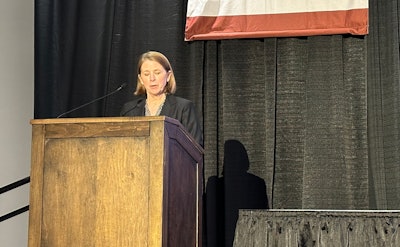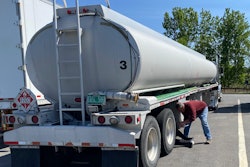
Following up on Thursday’s update regarding its plans to overhaul the system for motor carrier, broker and freight forwarder registration and updates, the Federal Motor Carrier Safety Administration on Friday provided an update on several of its in-the-works regulations at the Mid-America Trucking Show.
FMCSA Acting Deputy Administrator Sue Lawless opened Friday morning’s session thanking truck drivers for their work and recognizing the efforts of drivers to be safe on the nation’s highways.
She also highlighted work by the agency to help address drivers’ pain points in trucking, including the Truck Leasing Task Force working to address predatory lease-purchase agreements, studies looking at driver compensation and detention, grants provided to states to address the truck parking shortage, the Women of Trucking Advisory Board’s work to identify challenges for women in trucking and more.
“We are developing a new registration system to improve the transparency, efficiency and user experience of the agency’s registration systems, and to reduce fraud in the registration process,” Lawless said in reference to Thursday’s announcement.
[Related: FMCSA to end MC numbers, overhaul registration system to stamp out fraud]
Lawless also noted a couple of the agency’s current priorities, including accident prevention and ways to leverage technology to make the highways safer.
“We are always working to understand prevention,” she said. “If we can understand prevention, we can have the ability to understand how and why crashes happen and to prevent them from happening.”
Larry Minor, FMCSA’s Associate Administrator for Policy, also provided a brief update on three regulations the agency is actively working on -- automatic emergency brakes (AEB) mandate, the safe integration of automated driving systems, and transparency in broker transactions.
Minor said FMCSA and the National Highway Traffic Safety Administration are still working on a joint rulemaking that will require OEMs to install AEB systems on new trucks (the NHTSA rulemaking) and for fleets to maintain those systems (the FMCSA rulemaking).
The agencies published a notice of proposed rulemaking (NPRM) last summer and accepted public comments. Minor said the comments raised concerns about the durability, reliability and maintainability of the systems. He said a final rulemaking is in the works for publication this year, which will include a compliance date for having AEBs in trucks.
[Related: Are FMCSA and NHTSA skirting Congressional directive with AEB proposal?]
Regarding the integration of automated driving systems, Minor said the agency believes “it’s very important to have some safety oversight” to ensure autonomous systems deploy in a safe manner.
Minor said a draft NPRM is currently under review at the White House’s Office of Management and Budget -- and has been since December -- and will likely be published for public review and comment sooner than later.
As with all other rulemakings, Minor strongly encouraged truck drivers and other industry stakeholders to file comments when notices are published to alert the agency of any concerns or potential problems with the rulemaking.
Finally, Minor said FMCSA is still working toward a broker transparency rulemaking proposal by October. “When that notice of proposed rulemaking hits the street, we certainly encourage all of you to share your thoughts and feelings” about the proposal.
[Related: Potential broker-transparency rule not 'signficant,' yet FMCSA 'remains committed' to pursuit]
Absent from the regulatory updates was any mention of FMCSA's pursuit a potential revamp of its safety rating process, potentially to move to a simple fit/unfit rating scheme, as was the case last year at MATS.
This year, however, transportation attorney Hank Seaton, also speaking at MATS as part of a series of talks put on by Seaton's and other group’s Alliance for Safe, Efficient and Competitive Truck Transportation and the CDL Drivers Unlimited group, saw something of a piecemeal approach in the agency’s pursuit of several initiatives, including the safety rating revamp and the approach to fraud in the market aided by the agency’s outdated registration system. Seaton and others offered a more holistic approach, he felt, that might better keep bad actors out of the registration system and also offer a fair chance at a safety rating to the smallest entities.
“We advocate that any proposal” around safety ratings that uses CSA Safety Measurement System methodology and roadside inspection data “will take at least 10 years to perfect,” if it’s ever perfected, Seaton said. “The agency should adopt a new carrier/broker audit, a kind of prerequisite to issuing authority for a carrier or broker.”
Costs could at least in part be borne by new entrant entities themselves, Seaton said, and New Entrant Audit-like “desktop audits” could then be conducted every two years for every registered entity in the nation as a means of readily achieving and regularly updating a fit- or unfit-to-operate rating. Seaton and the coalition of carrier/broker/shipper groups he represents have long advocated for the latter approach as an effective and fair way to effectively rate a large sample of the entity population.
Adding a new-entity audit prior to the grant of authority -- and including brokers and forwarders in that mix -- would also tackle problems of fraud in the marketplace by keeping bad actors from infiltrating the trucking markets. “Add an anti-fraud provision for the new audit,” Seaton offered. “Have your auditor use a remote or on-site inspection to determine that” the applicant entity is who and where they say they are and that the business “is real.”
[Related: FMCSA making a run at revamp to carrier safety rating system]
FMCSA on Friday also provided a snapshot of trends in large truck and bus fatalities, with Tom Keane, Associate Administrator of FMCSA’s Office of Research & Registration, urging truck drivers to do their part to cut down on highway fatalities, particularly when it comes to protecting themselves.
Keane highlighted that truck occupant fatalities were up more than 25% over the five-year period from 2017-2021. In at least 40.6% of those fatalities, the victim was not wearing a seat belt, he said. Another 17% of truck occupant fatalities had no seat belt information reported by on-scene emergency personnel, he said. “The seat belt can literally save your life,” he added.










